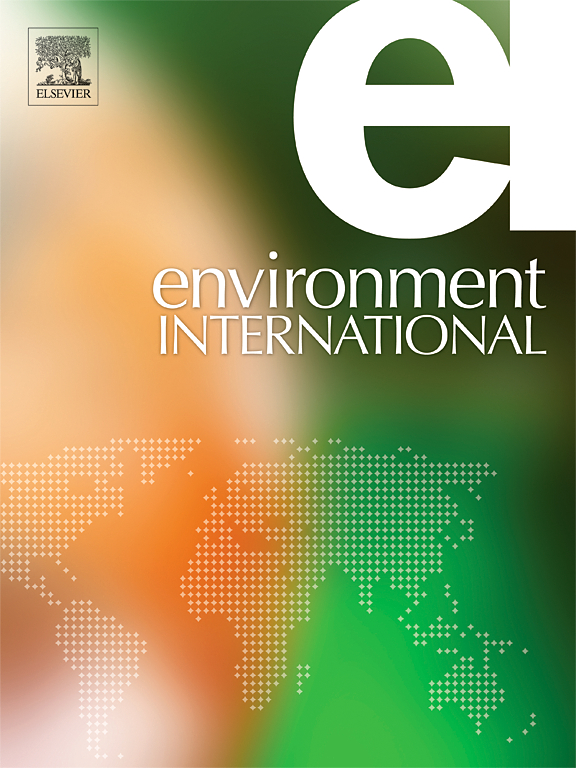绿色空间、噪音和空气污染对健康影响评估中死亡率负担量化的相关环境暴露的暴露-反应函数
IF 10.3
1区 环境科学与生态学
Q1 ENVIRONMENTAL SCIENCES
引用次数: 0
摘要
目的:绿色空间、空气污染(细颗粒物(PM2.5)或二氧化氮(NO2))和噪声的环境健康影响评估(HIA)使用基于流行病学研究的单次暴露模型的暴露-响应函数(ERF),未考虑其他常见相关暴露的潜在混淆。我们评估了单次和多次暴露模型之间erf的差异,以计算HIA对关节健康的影响。方法:我们系统地检索了报告单次和多次暴露模型的队列研究,以寻找长期暴露于以下暴露的任何组合绿地、PM2.5、NO2和噪音与全因死亡率之间的关系。对于每次暴露,通过荟萃分析计算合并危险比(hr),并比较单次和两次暴露模型。每个暴露对中两个暴露的联合效应表示为联合hr,通过乘以单个hr计算。计算系数差异,并使用人口归因分数(PAF)估计关节健康影响。结果确定了6项研究,检查了普通人群中多次暴露与死亡率之间的关系。这些研究表明,暴露水平和暴露之间的相关性存在很大差异。对于大多数暴露对,与单次暴露模型相比,调整第二次暴露导致hr适度减弱。联合单次暴露模型hr估计的死亡率paf高于两次暴露模型,表明在不考虑其他共同暴露的情况下,对死亡率负担的估计过高。例如,当调整绿地或噪声后,PM2.5的死亡率hr分别从1.071减弱到1.061和1.072减弱到1.055。就PAF而言,对于绿地- pm2.5对,单次暴露模型的PAF(0.090)比两次暴露模型的PAF(0.076)高18.4%。对于所有暴露对,两次暴露模型的联合paf均高于每次暴露的单次暴露模型的paf。本研究的汇总系数差异可用于调整荟萃分析的单次暴露erf,并允许计算多种环境暴露的综合影响,使HIA估算更加稳健和现实。本文章由计算机程序翻译,如有差异,请以英文原文为准。
Exposure-response functions of the correlated environmental exposures green space, noise, and air pollution for quantifying mortality burden in health impact assessment
Objective
Environmental health impact assessments (HIA) on green space, air pollution (fine particulate matter (PM2.5) or nitrogen dioxide (NO2)), and noise use exposure–response functions (ERF) based on single-exposure models from epidemiological studies, not accounting for potential confounding by other commonly correlated exposures. We assessed differences in ERFs between single- and multi-exposure models for calculation of joint health impacts in HIA.
Methods
We systematically searched cohort studies that reported both single- and multi-exposure models for associations of long-term exposure to any combination of the following exposures green space, PM2.5, NO2, and noise, with all-cause mortality. For each exposure, pooled hazard ratios (HRs) were calculated by meta-analyses and compared between single- and two-exposure models. The joint effects of two exposures in each exposure pair were expressed as joint HRs calculated by multiplying the individual HRs. Coefficient differences were calculated, and population attributable fractions (PAF) were used to estimate joint health impacts.
Results
Eleven studies were identified, examining associations between multiple exposures and mortality in the general population. The studies show substantial variability in exposure levels and correlations between exposures. For most exposure pairs, adjusting for a second exposure resulted in moderately attenuated HRs compared to single-exposure models. The mortality PAFs estimated from joint single-exposure model HRs were higher than those from two-exposure models, indicating an overestimation of mortality burden when not accounting for other co-exposures. For example, when adjusted for green space or noise, the mortality HRs for PM2.5 were attenuated from 1.071 to 1.061 and 1.072 to 1.055, respectively. As for PAFs, for the green space-PM2.5 pair, the single-exposure model PAF (0.090) was 18.4% higher than the two-exposure model (0.076). For all exposure pairs, the joint PAFs of two-exposure models were higher than the PAFs from the single-exposure models for each exposure individually.
Conclusion
The pooled coefficient differences from this study can be used to adjust single-exposure ERFs from meta-analyses and allow the calculation of combined impacts from multiple environmental exposures, making HIA estimates more robust and realistic.
求助全文
通过发布文献求助,成功后即可免费获取论文全文。
去求助
来源期刊

Environment International
环境科学-环境科学
CiteScore
21.90
自引率
3.40%
发文量
734
审稿时长
2.8 months
期刊介绍:
Environmental Health publishes manuscripts focusing on critical aspects of environmental and occupational medicine, including studies in toxicology and epidemiology, to illuminate the human health implications of exposure to environmental hazards. The journal adopts an open-access model and practices open peer review.
It caters to scientists and practitioners across all environmental science domains, directly or indirectly impacting human health and well-being. With a commitment to enhancing the prevention of environmentally-related health risks, Environmental Health serves as a public health journal for the community and scientists engaged in matters of public health significance concerning the environment.
 求助内容:
求助内容: 应助结果提醒方式:
应助结果提醒方式:


